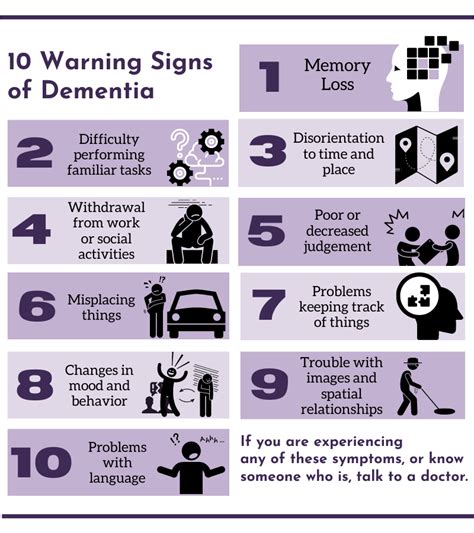
Recognizing early warning signs of Alzheimer’s disease is crucial for timely diagnosis and intervention, potentially improving quality of life for affected individuals and their families. Memory loss that disrupts daily life, challenges in planning or problem-solving, difficulty completing familiar tasks, confusion with time or place, and trouble understanding visual information are among the key indicators to watch for, according to the Alzheimer’s Association.
Early detection empowers individuals and their families to make informed decisions about care, treatment options, and future planning. While there is currently no cure for Alzheimer’s, early diagnosis allows access to treatments that can help manage symptoms and maintain cognitive function for a longer period.
The Alzheimer’s Association emphasizes that these signs are not merely typical age-related changes and warrant medical evaluation. Differentiating between normal aging and early Alzheimer’s is essential for initiating appropriate care and support.
Ten Early Signs of Alzheimer’s Disease
The following ten signs, outlined by the Alzheimer’s Association, serve as crucial indicators that warrant further evaluation by a medical professional:
-
Memory Loss That Disrupts Daily Life: This goes beyond occasionally forgetting names or appointments. It involves forgetting recently learned information, repeatedly asking the same questions, and relying heavily on memory aids or family members for things one used to handle independently. “One of the most common signs of Alzheimer’s is memory loss, especially forgetting recently learned information,” the Alzheimer’s Association notes.
This type of memory loss significantly impairs daily functioning, affecting the ability to remember important dates or events and requiring increasing reliance on external aids.
-
Challenges in Planning or Problem-Solving: Difficulty following a recipe, managing finances, or keeping track of monthly bills can signal a decline in executive function. People with early Alzheimer’s may struggle to develop and follow a plan or work with numbers. They may also have trouble concentrating and take much longer to do things than they did before.
This cognitive decline is more than the occasional error; it’s a persistent and noticeable change in one’s ability to manage complex tasks.
-
Difficulty Completing Familiar Tasks: Struggling to complete routine tasks at home, at work, or during leisure activities can be a sign. This might involve trouble driving to a familiar location, remembering the rules of a favorite game, or forgetting how to prepare a meal they’ve made countless times.
The Alzheimer’s Association highlights that this symptom involves difficulty with tasks that were once automatic and effortless.
-
Confusion with Time or Place: Losing track of dates, seasons, and the passage of time, or forgetting where they are or how they got there, are common indicators. Individuals may also struggle to understand events that are not happening immediately.
Such confusion can be disorienting and may lead to anxiety and frustration.
-
Trouble Understanding Visual Information and Spatial Relationships: Experiencing difficulty reading, judging distance, or determining color or contrast can be indicative of Alzheimer’s. This is not simply a matter of age-related vision changes; it’s a cognitive difficulty processing visual information.
This can also cause problems with driving, such as difficulty judging distances and differentiating colors, creating a significant safety hazard.
-
New Problems with Words in Speaking or Writing: Individuals may have trouble following or joining a conversation. They might stop in the middle of a conversation and have no idea how to continue, or they may repeat themselves. They may struggle with vocabulary, have problems finding the right word, or call things by the wrong name.
This difficulty extends beyond the occasional tip-of-the-tongue experience; it’s a persistent and noticeable struggle with language.
-
Misplacing Things and Losing the Ability to Retrace Steps: Putting things in unusual places and being unable to go back and find them is a warning sign. The person may accuse others of stealing, especially as the disease progresses.
This is more than just misplacing keys; it involves a pattern of misplacing items and being unable to retrace steps to locate them, often accompanied by suspicion and paranoia.
-
Decreased or Poor Judgment: Changes in judgment or decision-making, such as using poor judgment when dealing with money, giving large amounts to telemarketers, or paying less attention to grooming or keeping themselves clean, are red flags.
This can lead to financial exploitation, neglecting personal hygiene, and making poor choices that impact safety and well-being.
-
Withdrawal from Work or Social Activities: A person with Alzheimer’s may start to withdraw from hobbies, social activities, work projects, or sports. They may have trouble keeping up with a favorite team or remembering how to do a favorite hobby.
This withdrawal often stems from the individual’s awareness of their cognitive decline and a desire to avoid situations where their difficulties might be exposed.
-
Changes in Mood and Personality: Individuals may become confused, suspicious, depressed, fearful, or anxious. They may be easily upset at home, at work, with friends, or in places where they are out of their comfort zone.
These mood swings can be unpredictable and distressing for both the individual and their caregivers.
The Importance of Early Detection
While there is no cure for Alzheimer’s disease, early detection offers significant benefits:
-
Access to Treatment: Medications, such as cholinesterase inhibitors and memantine, can help manage cognitive and behavioral symptoms. While these drugs do not cure Alzheimer’s, they can improve quality of life and maintain cognitive function for a period of time.
-
Participation in Clinical Trials: Early diagnosis allows individuals to participate in clinical trials for new treatments and therapies that may slow or prevent the progression of the disease.
-
Planning for the Future: Early detection enables individuals and their families to make informed decisions about legal, financial, and caregiving arrangements. This includes creating advance directives, appointing a power of attorney, and exploring long-term care options.
-
Support and Education: Early diagnosis provides access to support groups, educational resources, and counseling services that can help individuals and families cope with the challenges of Alzheimer’s disease.
-
Addressing Co-existing Conditions: Early diagnosis allows for the identification and treatment of other medical conditions that may be contributing to cognitive decline, such as depression, sleep apnea, or thyroid problems.
Distinguishing Between Normal Aging and Alzheimer’s
It is essential to differentiate between normal age-related cognitive changes and the warning signs of Alzheimer’s disease. Some normal age-related changes include:
- Occasionally misplacing keys or glasses.
- Having trouble remembering a name or word.
- Forgetting an appointment but remembering it later.
- Making a bad decision once in a while.
- Feeling sad or moody from time to time.
These changes are typically mild and do not significantly impact daily functioning. In contrast, the warning signs of Alzheimer’s disease are more persistent, severe, and disruptive.
Risk Factors for Alzheimer’s Disease
While the exact cause of Alzheimer’s disease is not fully understood, several risk factors have been identified:
-
Age: The greatest known risk factor for Alzheimer’s disease is increasing age. The risk of developing Alzheimer’s doubles every five years after age 65.
-
Family History: Individuals with a parent, sibling, or child who has Alzheimer’s disease are at a higher risk of developing the disease themselves.
-
Genetics: Certain genes have been linked to an increased risk of Alzheimer’s disease.
-
Lifestyle Factors: Factors such as diet, exercise, and social engagement may play a role in the development of Alzheimer’s disease.
-
Cardiovascular Health: Conditions that affect the heart and blood vessels, such as high blood pressure, high cholesterol, and diabetes, may increase the risk of Alzheimer’s disease.
-
Traumatic Brain Injury: Some studies suggest that a history of traumatic brain injury may increase the risk of Alzheimer’s disease.
Diagnosis and Evaluation
If you or someone you know is experiencing any of the warning signs of Alzheimer’s disease, it is important to consult with a medical professional. The diagnostic process typically involves:
-
Medical History: The doctor will ask about the individual’s medical history, family history, and current medications.
-
Physical Examination: A physical examination will be performed to assess the individual’s overall health.
-
Neurological Examination: A neurological examination will be conducted to assess the individual’s cognitive function, reflexes, and motor skills.
-
Cognitive Tests: Cognitive tests, such as the Mini-Mental State Examination (MMSE) or the Montreal Cognitive Assessment (MoCA), will be administered to assess memory, attention, and language skills.
-
Brain Imaging: Brain imaging techniques, such as MRI or CT scans, may be used to rule out other causes of cognitive decline, such as stroke or tumors. PET scans can also be used to detect amyloid plaques and tau tangles, which are hallmarks of Alzheimer’s disease.
-
Blood Tests: Blood tests may be performed to rule out other medical conditions that can cause cognitive decline, such as thyroid problems or vitamin deficiencies.
Living with Alzheimer’s Disease
Living with Alzheimer’s disease presents significant challenges for both the individual and their caregivers. Strategies for managing the disease and improving quality of life include:
-
Creating a Safe and Supportive Environment: Minimizing clutter, removing hazards, and providing adequate lighting can help prevent falls and injuries.
-
Establishing a Routine: Maintaining a consistent daily routine can help reduce confusion and anxiety.
-
Simplifying Tasks: Breaking down complex tasks into smaller, more manageable steps can help the individual maintain independence.
-
Communicating Clearly and Simply: Using simple language, speaking slowly, and avoiding jargon can help the individual understand instructions and information.
-
Providing Social and Emotional Support: Encouraging social interaction, providing opportunities for engagement in meaningful activities, and offering emotional support can help improve the individual’s mood and well-being.
-
Seeking Caregiver Support: Caregiving for someone with Alzheimer’s disease can be physically and emotionally demanding. Caregivers should seek support from family, friends, support groups, and professional caregivers.
Future Directions in Alzheimer’s Research
Alzheimer’s research is rapidly advancing, with numerous ongoing studies exploring new treatments, diagnostic tools, and prevention strategies. Some promising areas of research include:
-
Amyloid and Tau Targeting Therapies: These therapies aim to reduce or remove amyloid plaques and tau tangles from the brain.
-
Immunotherapies: These therapies use the body’s own immune system to attack amyloid plaques and tau tangles.
-
Neuroprotective Agents: These agents aim to protect brain cells from damage and death.
-
Lifestyle Interventions: Studies are investigating the potential of lifestyle interventions, such as diet, exercise, and cognitive training, to prevent or delay the onset of Alzheimer’s disease.
-
Biomarkers: Researchers are working to identify biomarkers that can detect Alzheimer’s disease at its earliest stages, even before symptoms appear.
Conclusion
Recognizing the early warning signs of Alzheimer’s disease is crucial for early diagnosis and intervention. While there is currently no cure for Alzheimer’s, early detection allows access to treatments that can help manage symptoms, improve quality of life, and enable individuals and families to plan for the future. If you or someone you know is experiencing any of the warning signs of Alzheimer’s disease, it is important to consult with a medical professional.
Frequently Asked Questions (FAQ)
1. What is the difference between normal age-related memory loss and Alzheimer’s disease?
Normal age-related memory loss involves occasional forgetfulness, such as misplacing keys or forgetting a name momentarily. These instances are generally infrequent and do not significantly disrupt daily life. Alzheimer’s disease, however, involves persistent and progressive memory loss that interferes with daily activities. This includes difficulty remembering recently learned information, repeatedly asking the same questions, and relying on memory aids or family members for tasks one used to handle independently. The Alzheimer’s Association states that “one of the most common signs of Alzheimer’s is memory loss, especially forgetting recently learned information.” In essence, normal aging involves minor lapses, while Alzheimer’s presents a pattern of significant cognitive decline.
2. Are there any medications that can cure Alzheimer’s disease?
Currently, there is no cure for Alzheimer’s disease. However, several medications are available to help manage the symptoms and improve the quality of life for individuals living with the condition. Cholinesterase inhibitors, such as donepezil (Aricept), rivastigmine (Exelon), and galantamine (Razadyne), can help improve cognitive function by increasing the levels of acetylcholine, a neurotransmitter involved in memory and learning. Memantine (Namenda) is another medication that can help improve cognitive function by regulating the activity of glutamate, another neurotransmitter. These medications do not stop or reverse the progression of Alzheimer’s, but they can provide temporary relief from some of the symptoms. Research into potential cures and disease-modifying treatments is ongoing.
3. What lifestyle changes can help reduce the risk of developing Alzheimer’s disease?
While there is no guaranteed way to prevent Alzheimer’s disease, several lifestyle changes can help reduce the risk. Maintaining a healthy diet rich in fruits, vegetables, and whole grains, while limiting processed foods, saturated fats, and added sugars, is crucial. Regular physical exercise, such as walking, swimming, or cycling, can improve cardiovascular health and cognitive function. Engaging in mentally stimulating activities, such as reading, puzzles, and learning new skills, can help keep the brain active and resilient. Social engagement and maintaining strong social connections can also protect against cognitive decline. Managing cardiovascular risk factors, such as high blood pressure, high cholesterol, and diabetes, is important, as these conditions are linked to an increased risk of Alzheimer’s. Getting adequate sleep and managing stress are also essential for brain health.
4. What should I do if I suspect that a loved one has Alzheimer’s disease?
If you suspect that a loved one has Alzheimer’s disease, the first step is to encourage them to see a doctor for a comprehensive evaluation. This evaluation typically includes a medical history, physical examination, neurological examination, cognitive tests, and possibly brain imaging. It’s important to approach the conversation with sensitivity and empathy, explaining your concerns in a non-accusatory manner. Offer to accompany them to the appointment and provide support throughout the process. If the doctor confirms a diagnosis of Alzheimer’s disease, work together to develop a care plan that addresses their needs and preferences. This may involve medication, therapy, lifestyle changes, and support services. Remember that early diagnosis and intervention can help improve their quality of life and allow them to participate in decisions about their care.
5. Where can I find resources and support for caregivers of individuals with Alzheimer’s disease?
Caring for someone with Alzheimer’s disease can be challenging, but numerous resources and support services are available to help caregivers. The Alzheimer’s Association is a leading organization that provides information, education, support groups, and advocacy for individuals with Alzheimer’s and their families. Local chapters of the Alzheimer’s Association can connect you with resources in your community. The National Institute on Aging (NIA) offers information about Alzheimer’s disease and caregiving on its website. Adult day care centers provide a safe and stimulating environment for individuals with Alzheimer’s, offering caregivers a break from their responsibilities. Respite care services provide temporary care for individuals with Alzheimer’s, allowing caregivers to take a vacation or attend to other needs. Home health agencies can provide in-home care services, such as personal care, medication management, and skilled nursing. Seeking support from family, friends, and other caregivers is also essential for maintaining your own well-being.









